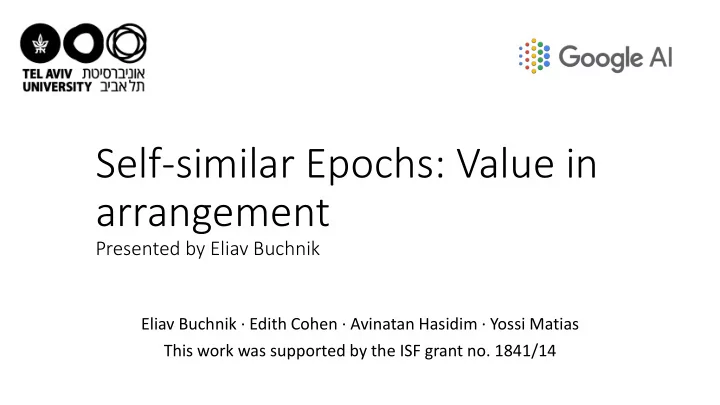

Self-similar Epochs: Value in arrangement Presented by Eliav Buchnik Eliav Buchnik · Edith Cohen · Avinatan Hasidim · Yossi Matias This work was supported by the ISF grant no. 1841/14
Arrangement methods of training examples for Stochastic Gradient Descent(SGD) • We explore arrangement method of training examples as an optimization knob for SGD • The common baseline is i.i.d. arrangement. The drawback is that sub-epochs lose the structure of the full data. • We present Self-Similar arrangements. ➢ Keep the marginal distribution of training examples but sub-epochs do preserve the structure. • Method can be combined with many other optimization knobs of SGD. • Accelerate training time by 3%-37%
Test case - matrix factorization Data is pairwise interactions: word co-occurrences, user-movie ratings/views: Movie User Rating Movies Users Ratings Produce an embedding vector for each entity (e.g. user or movie) so that interactions (e.g. views) can be recovered (and new ones predicted) from embeddings (e.g. SGNS by Mikolov et al., …)
Test case - matrix factorization Movies Ratings Users The training sequence is formed from i.i.d samples
Test case - matrix factorization Movies Ratings Users The training sequence is formed from i.i.d samples Update embeddings ……
Motivation: Identical rows Consider two users with identical movie preferences Movies Ratings Users Ideally the end result is two (nearly) identical embeddings To recover this similarity from a sub-epochs we need it to contain examples where they rate the same movies. I.i.d arrangements: The samples of the two users are likely to be very different. Similarity structure is lost
Self-similar epochs “self - similar”:= preserves similarity structure in a sub epochs. We hypothesize that “self - similar” arrangements will allow one epoch to act as multiple ones and thus help SGD converge faster. Movies Ratings Users
Self-similar epochs “self - similar”:= preserves similarity structure in a sub epochs. We hypothesize that “self - similar” arrangements will allow one epoch to act as multiple ones and thus help SGD converge faster. Movies Ratings Users …. Update embeddings
Properties of our arrangement method • Does not change the marginal distribution of examples • Sub-epochs preserve in expectation the weighted Jaccard similarities of pairs of rows and columns. σ 𝑗 min(𝑣 𝑗 ,𝑤 𝑗 ) ❖ 𝐾 𝑣, 𝑤 = σ 𝑗 max(𝑣 𝑗 ,𝑤 𝑗 ) Algorithms: • Preprocessing step with cost linear in the sparsity of the matrix. • During training the cost is 𝑃(1) per example drawn Results: • Acceleration of between 3%-37% in training time.
Thank you! Details at poster #60
Recommend
More recommend